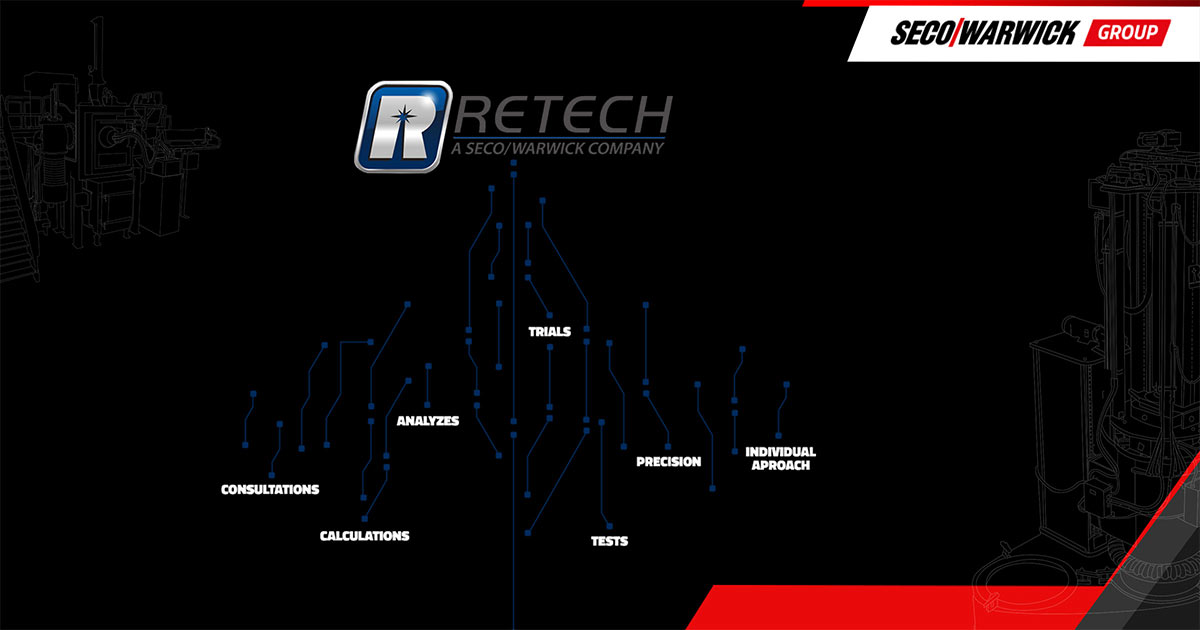SECO/WARWICK Group
SECO/WARWICK Group?
The SECO/WARWICK Group › Read more
Expanite
What is Expanite? Surface Hardening of Stainless Steel
EXPANITE® as well as SUPEREXPANITE® are patented processes for the surface hardening of stainless steel to achieve superior surface and material properties, such as high hardness, extraordinary corrosion and fatigue properties. › Read more
Vacuum
What is HPGQ?
What is High Pressure Gas Quenching (HPGQ)?
The most common definition for High Pressure Gas Quenching is accelerating the rate (speed) of quenching by densification and cooling of gas. One of the reasons for the intense interest in this quenching technique is related to improved part distortion with full hardness. A critical concern is to avoid sacrifice of metallurgical, mechanical or physical properties. That is, retain the ability to transform a material to a microstructure that is similar, identical or superior to that of a known quenching medium (e.g. oil or salt). Common quench gases include nitrogen, argon and helium. Hydrogen, although excellent with respect to heat transfer, is seldom used as a quench gas due to safety considerations.
High Pressure Gas Quenching (HPGQ) offers a number of attractive benefits including unprecedented part cleanliness and less overall dimensional change. Fixed or variable cooling rates are applied as required to control hardness and distortion with the ability to vary quench pressure depending on load size, material type and part section thickness. Product consistency and repeatability are excellent using high pressure gas quenching.
What is a vacuum furnace?
The most important facts about a vacuum furnace
Vacuum furnaces are used in many applications in all industries. A vacuum is one of the methods to protect heated steel and metal parts from the negative influence of an air atmosphere. A vacuum furnace is normally an electrically heated furnace in which a vacuum is maintained during the process. Most vacuum furnaces are heated by electric resistance elements made from graphite, ceramics or metals.
Gas heated vacuum furnaces by SECO/WARWICK
SECO/WARWICK can supply gas heated vacuum furnaces. A gas heated vacuum furnace is not direct heated by open burners, but indirectly as a vacuum retort furnace or a vacuum furnace with vacuum-tight radiation burner tubes.
The vacuum in the furnace is maintained by vacuum pumps. Depending on the application, a single or combination of mechanical and booster, diffusion and turbo-molecular pumps are used.
Atmosphere
What is a radiation tube?
A radiation tube is a kind of heating element. The radiation tube might be integrated with the burner or electrical heating element:
- the tube integrated with the burner separates both flame and combustion gas from the technological atmosphere in the heating chamber;
- the tube integrated with electrical heating element protects the heating element against damaging influence of furnace technological atmosphere.
What are the advantages of a SECO/WARWICK roller hearth furnace?
Roller Hearth Furnace Systems › Read more
What is an application for a roller hearth furnace?
SECO/WARWICK designs and builds roller hearth continuous furnaces for annealing both in-process and finished tubes in ferrous, nonferrous, and stainless steel materials. › Read more
What is causing the high dew point in my atmosphere generator?
One of the common problems encountered in generators is that of a high dew point. This could be caused by a leak in the gas cooler which is of the tube type water cooler. If it is a leaky gas cooler, the correction is obvious – repair it. If the water cooler is not leaking and it is still running a high dew point, it is possible that the generator is getting more air than indicated on the flowmeter. Sources of air infiltration into the generator are through the pump shaft, a bad bypass regulator, or loose piping. › Read more
How to find where air is infiltrating atmosphere furnaces
Infiltration of air into atmosphere furnaces
A problem encountered in the operation of the furnace, particularly atmosphere furnaces, is the infiltration of air into the furnace chamber or cooling chamber.
Usually, the problem of air being drawn into a furnace is due to the deterioration of radiant tube seals, bearings, door seals, cracked welds, or leaking cooling chambers. One means of determining this in atmosphere furnaces is to pressurize the furnace as tightly as possible and check all bearings, radiant tube ports, door seals, etc., with soap bubbles. One thing that people find hard to imagine is that even though a furnace is operating under pressure, it can still draw air into the chamber. One thing you can be certain of is when a furnace is under pressure and atmosphere is leaking out, this means that air can leak in. Some of the causes of atmospheres or leaks can be as follows: Bearing not properly greased or packing around access plugs or radiant tube plugs or fan plugs has hardened and deteriorated so as not to provide a seal. Another source of air entrance into a furnace is through a cracked radiant tube. When a process problem does occur and it has been determined that the atmosphere gas going to the furnace is good, all the above points should be checked and corrected to cure the problem.
Nitriding
What is the nitriding potential?
The nitriding potential is thermodynamically defined by:
where „pNH3” and “pH2” are the partial pressures of the ammonia and hydrogen gases respectively. This potential defines the possibility of creating the nitrogen layers of determined structure. Generally – the higher potential is the resulting phases richer in nitrogen are. The phase structure of nitrogen layers as a function of potential and temperature is presented in Lehrer’s chart.
CAB
What is the fluxer?
Fluxers
The cleaned heat exchanger is covered with a suitable layer of brazing and flux mixture prior to start of the brazing process.
We deliver the following fluxer types:
Spray fluxers The spray method is used to apply chemical suspensions mixed with water. This is the most widespread method and most often used.
Painting fluxers This equipment is specifically intended for heat exchanger elements that are not accessible by spray fluxers.
Immersion fluxers Some heat exchangers available on the market feature a design that requires application of flux to internal spaces. In this case, the spray application of the flux does not assure appropriate preparation of the joint for brazing. SECO/WARWICK immersion fluxers are a solution to this problem.
Electrostatic fluxers are an alternative to “wet fluxing,” as they do not require a flux water solution to prepare.
General
What is an electron beam?
The definition of an electron beam
The free electrons in vacuum can be accelerated and their orbits controlled by electric and magnetic fields. In this way we can form narrow beams of electrons carrying high kinetic energy, which at collisions with atoms in solids transform their kinetic energy into heat. Thanks to some specific conditions, this way of heating gives us exceptional possibilities.
These conditions are:
- Strong electric field can accelerate electrons to a very high speed,
- Using magnetic lenses the beam can be shaped into a narrow cone and focused to a very small diameter with a very high power density in the plane of impingement of the beam on the surface of some solid,
- The depth of penetration of electrons into solids is in the order of hundredths of a millimeter. The volume density of power in the small volume in which the kinetic energy of electrons is transformed into heat (consecutively, the temperature in this volume increases extremely rapidly).
What are the resulting effects of the electron beam?
Resulting effect of the electron beam under such circumstances depends on conditions; -first of all on physical properties of the material. Any material in a very short time can be melted (or even evaporated).
What is scale?
Scale – a thick layer of metal oxides on the surface of heated parts, formed in an oxidizing atmosphere at high temperature.
What is the dew point ?
The dew point is the temperature below which the water vapor in a volume of humid air at a constant barometric pressure will condense into liquid water. Condensed water is called dew when it forms on a solid surface.
What is a furnace chain and a pair of furnace chains?
Furnace chains are high temperature resistant chains to transport a load, a fixture, a basket or a part in a furnace. Often these furnace chains are used in batch type furnaces (BT), in-out-furnaces (IO), batch integral quench furnaces (BIQ), Through-Quench furnaces (TQ), Return Through Quench furnaces (RTQ), casemaster furnaces (CM), Sealed Quench Batch furnace (SQ B and SQ ) where a pair of endless furnace chains right and left with dogs take a load from position A to position B in the furnace. Often the material mix of the chain is important, as a part of the chain remains in the hot furnace area, while the other one remains in the cold part. Naturally the cold part should do the job and pull the load from one to the other position.
SECO/WARWICK supplies furnace chains and service for S/W’s CaseMaster furnaces and many other manufacturer’s furnaces. Our experience helps you to select the correct furnace chain for your type of furnace
Why do we use oxygen probe?
Using an oxygen probe
We use oxygen probes because they enable quick regulation of the chemical constitution of the furnace atmosphere. Using the oxygen probe one can measure the amount of oxygen, which allows to calculate the carbon potential of the furnace atmosphere online.
What are heat treatment problems?
The heat treatment process is often the last or one of the last, but certainly in most cases one of the important steps in the manufacturing and production of metal parts, semi-finished metal parts and metal fore products for the production of the before mentioned products. › Read more
Fundamentals
What is Heat Treatment
Heat Treatment is the controlled heating and cooling of metals to alter their physical and mechanical properties without changing the product shape. Heat treatment is sometimes done inadvertently due to manufacturing processes that either heat or cool the metal such as welding or forming.




